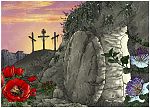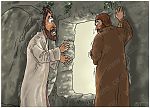Bible Cartoon: John 20 - The Resurrection - Scene 01 - Stone removed (Version 02)
Click on Add to cart button below shopping cart.
Purchased Bible Cartoons do not have watermarks. Links to Cartoons provided on email once purchase is completed.Bible Book: John
Bible Book Code: 4302000102
Scene no: 1 of 2
Bible Reference & Cartoon Description
John 20:1 (NLT)
The Resurrection
Early Sunday morning, [1] while it was still dark, Mary Magdalene came to the tomb and found that the stone had been rolled away from the entrance.
[1]
Greek, On the first day of the week.
DRAWING NOTES:
TIME OF DAY:
Verse 1 informs us it is “Early Sunday morning”.
LIGHTING NOTES:
The verse above tell us “while it was still dark”. I have drawn this scene with the glow of the unrisen sun behind the three crosses on the hill of Golgotha, the centre cross was the one on which Jesus was crucified.
CHARACTERS PRESENT:
None.
ADDITIONAL/RESEARCH NOTES:
This scene shows the large tomb stone rolled aside. Notice the light that is coming from the tomb, which is my representation of the power of God used in resurrecting Jesus from the dead.
There are two versions of this scene:
01) (This page) John 20 – The empty tomb – Scene 01 – Stone removed (Version 01).
02) (Next page) John 20 – The empty tomb – Scene 01 – Stone removed (Version 02).
Differences between the 2 versions of this scene
01) Version 01 has no figures in it, as I wanted to focus the viewer’s attention on the three crosses, sunrise and stone of the tomb. Version 02 has three small female figures, coming down the steps in the middle distance. The woman in front is Mary Magdalene. Here’s a close-up of the figures.

John 20 – The Resurrection – Scene 01 – Stone removed – PARTIAL 01
02) In Version 01 I have made the rocks grey-green, whereas in Version 02 I have added an underlying pale pink tone to them.
03) Another difference between these 2 versions is the intensity of the sunrise reflected off the clouds in the pre-dawn sky. The colours are deliberately brighter in Version 02.
04) There are lighter pre-dawn sunlight reflections on the plants and tomb rock face in Version 02.
05) A further difference between the scene versions can be observed in the various plants and flowers depicted. In Version 01 I have deliberately used brighter colours, whereas the plants and flowers are muted and darker in Version 02, which tends to make them recede a little more into the scene, rather than stand out so much, as they do in Version 01.
Here’s the initial 2 greyscale pencil sketch of this scene, which helps me to establish the positions and sizes of the various elements in the picture.

John 20 – The Resurrection – Scene 01 – Stone removed – pencil Greyscale
Here’s the scene in greyscale form, which I create before I colour up a scene, to get the tone (light and shade) right.

John 20 – The Resurrection – Scene 01 – Stone removed – Greyscale
Plants in this scene
The flowering plant in the right foreground and on the plants clinging to the cliff walls is the caper bush (Capparis spinosa) who’s edible bud and fruit (caper berry) are usually eaten pickled.
The red flowering plant in the foreground is the crown anemone (Anemone coronaria). I decided to use a bright red plant as a reflection of the blood spilt by Jesus on the cross.
I was tempted to draw a variety of the family Passifloraceae, (aka passion flowers or passion vines), and especially Pasiflora caerulea (the Blue passion flower) since that variety shows most of the elements of the Christian symbolism associated with this flower (see notes below). However, Passifloracea is not native to Israel, so you wouldn’t have seen it near Jesus’ tomb. It would have been a great and symbolic plant to draw, but since it doesn’t belong there, and I want to draw authentic pictures wherever possible, I couldn’t include it in my scene…oh well!
Passifloraceae flower Christian symbolism.
The pointed tips of the leaves were taken to represent the Holy Lance that pierced Jesus’ side.
The tendrils represent the whips used in the flagellation of Christ.
The ten petals and sepals represent the ten faithful apostles (excluding St. Peter the denier and Judas Iscariot the betrayer).
The flower’s radial filaments, which can number more than a hundred and vary from flower to flower, represent the crown of thorns.
The chalice-shaped ovary with its receptacle represents a hammer or the Holy Grail
The 3 stigmas represent the 3 nails and the 5 anthers below them the 5 wounds (four by the nails and one by the lance).
The blue and white colours of many species’ flowers represent Heaven and Purity.






